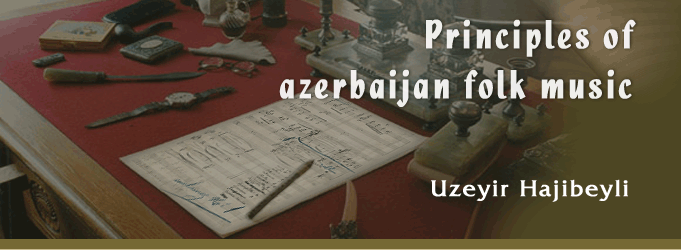

HISTORICAL INFORMATIONTwo Azerbaijan musical theorists take a leading place in history of the Middle East music. These worldwide scientists mostly affected development of theory and practice of the eastern music. They are: Safiaddin-Abdulmoumin ibn-Yusif-al Urmavi (from Urmiya) - XIII century; and Abdulgadir Maraghi (from Maragha) - XIV century.
Azerbaijan scientist-musicologist Navvab Mir Mohsin was the son of Haji Seid Ahmad Garabaghi from Shusha (XIX century). He spoke about the Middle Eastern music in his booklet "Vizuhul-Argam" (Interpretation of musical terms). In his book he proceeded from the works of the above two scholars. All these works (a part of them were translated into European languages) reveal that Middle Eastern musical culture reached its peak in XIV century. It proudly dominated as a twelve-columned, six-towered "building". From this building one could view all four directions of the world: from Andalusia to China and from Africa to the Caucasus. The following scholars, philosophers, and "architects" erected this "palace of musical culture":
Abu Nasr Farabi - a man of encyclopedic knowledge and expert in ancient Greek musical theory;
Abu-Ali ibn-Sina, a great philosopher and scientist known in Europe as Avicenna;
` Al-Kindi, and others.
It seemed the "construction" to be strongly balanced. 12 columns supporting "the palace of music" were represented by 12 essential mugams.They were:
Ushshag
Nava
Busalik
Rast
Iraq
Isfahan
Zirafkand
Buzurk
Zangula
Rahavi
Husseini
HijazSix towers were represented by 6 avazats.
They were the following:Shahnaz
Maya
Salmak
Novruz
Gardaniya
KuvashtSocio-economic and political changes at the end of the XIV century affected this luxurious palace of music". The fatal cracks appeared in the walls finally doomed it to death, columns and towers of this "palace" tumbled down, and the "palace collapsed.
Peoples of the Middle East used the valuable "debris" of this collapsed "palace of music". They erected their own "temple of music", in a style peculiar to that people only, using own "mode construction" material. Naturally, the names of 12 classic mugams, as well as the mugams themselves, were subjected to great perturbations. Those once considered as independent mugams, turned into the sections of those mugams. And on the contrary, those that once were sections, turned into independent mugams. In this way, the names of one and the same mugams and their sections started to denote quite different notions at various peoples. The only mugam that could stand against the crushing influences of time and events was "Rast". Foundations of this mugam are so firm and logical that they fully deserve and justify the name and the meaning of "Rast". The word "rast" means "straight", "right", "true". Ancient musicologists called "Rast" mother of all mugams. The mugam "Rast" has retained up to now not only its name and the structure of its scale, but the pitch of its tonic, as well.
Amongst all the Middle Eastern peoples the mugam "Rast" has one structure, and one pitch of tonic. This tonic is sol of minor octave. The following comparison shows that the tone we call sol of minor octave, referred to the pitch of the "Rast" mode even in antiquity. So, Arabian - Iranian and European musicologists assert that according to the ancient Greeks, 7 tones invented by Pythagoras correspond to 7 celestial bodies.
Here is a list of the seven tones:
In Gгeek
In Arabic and Iranian
1. mi - Moon
2. fa - Mercury
3. sol - Venus
4. la - Sun
5. si - Mars
6. do - Jupiter
7. re - Saturn1. Nava
2. Busalik
3. Rast
4. Iraq
5. Ushshag
6. Zirafkand
7. Rahavi
Azerbaijani folk music passed a long way of evolution up to the moment. Due to the most favourable conditions it reached the peak of its flourishing.
Scientific and theoretical analysis of Azerbaijan folk music, tasnifs, diringas, rhapsodies, dance tunes, and others show that Azerbaijani musical art is based on a strict and harmonious system. And all the scientific and theoretical provisions of Azerbaijani folk music proceed from this system.